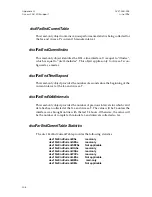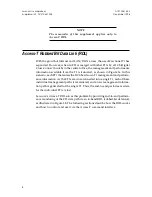
mum packet size of 50 bytes. Access-T’s maximum size is
limited to 1500.
•
Async-Control-Character-Map:
Bit map of control charac-
ters (characters whose ASCII values are less than 0x20) which
should be discarded if found in the data stream. If character
is not to be discarded, then the sender must either perform
byte stuffing (replace character with a 2-byte escape se-
quence) or negotiate a compatible map.
Access-T supports this option on both receive and transmit.
However, byte stuffing shall always be performed when
transmitting LCP or IPCP packets. Access-T can receive all
control characters without byte stuffing.
•
Protocol-Field-Compression:
When negotiated, the proto-
col field can be reduced to a single byte.
Access-T supports this option on both receive and transmit.
Note that only the IP protocol can be reduced.
•
Address-and-Control-Field-Compression:
When negoti-
ated, the address and control field can be omitted.
Access-T supports this option on transmit only and only for
non-LCP packets. Access-T cannot receive packets with these
two fields omitted.
•
Echo-Request and Discard-Request LCP commands will never be
sent. These commands though useful for debugging, performance
testing, and link quality determination are not a necessity.
IPCP
IPCP implementation is per RFC 1332. After link options are negotiated with
LCP, the two ends must negotiate for acceptance of IP packets. The protocol
used for this negotiation is called IP Control Protocol (IPCP). IPCP packets are
encapsulated within PPP packets.
The IPCP implementation for Access-T does not support any options on receive
or transmit.
Appendix I
ACST-0351-005
Point-to-Point Protocol
June 1996
I–2






























